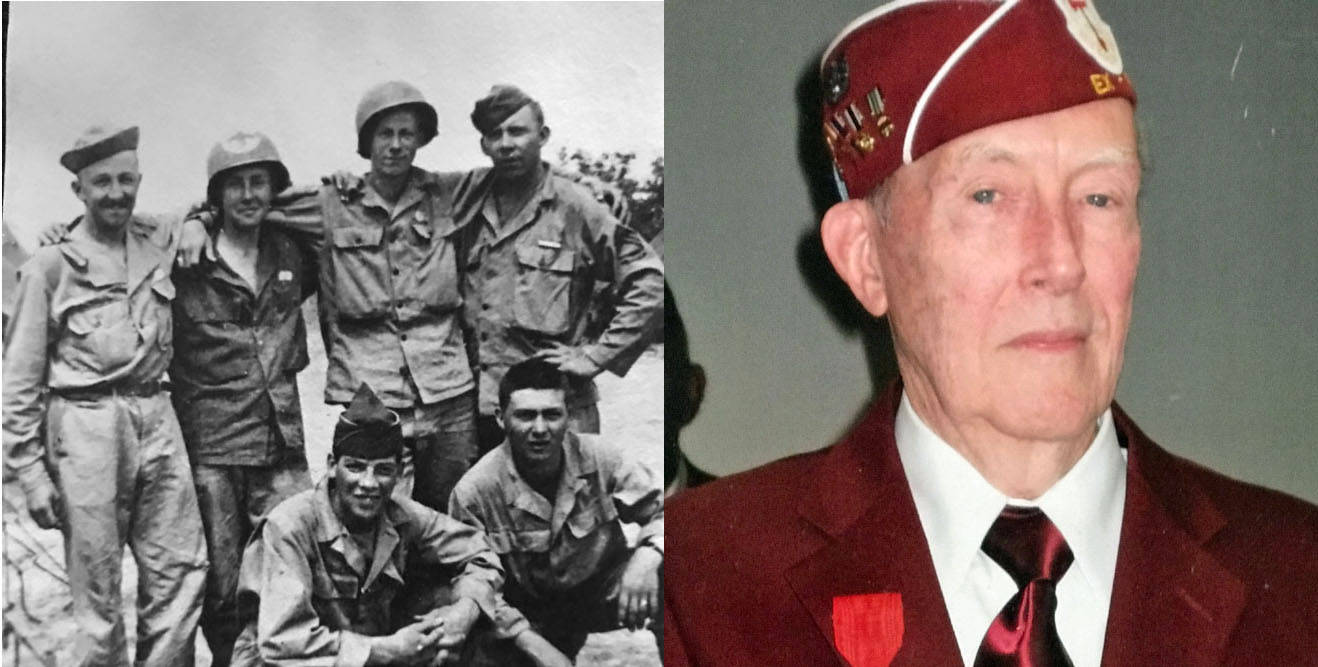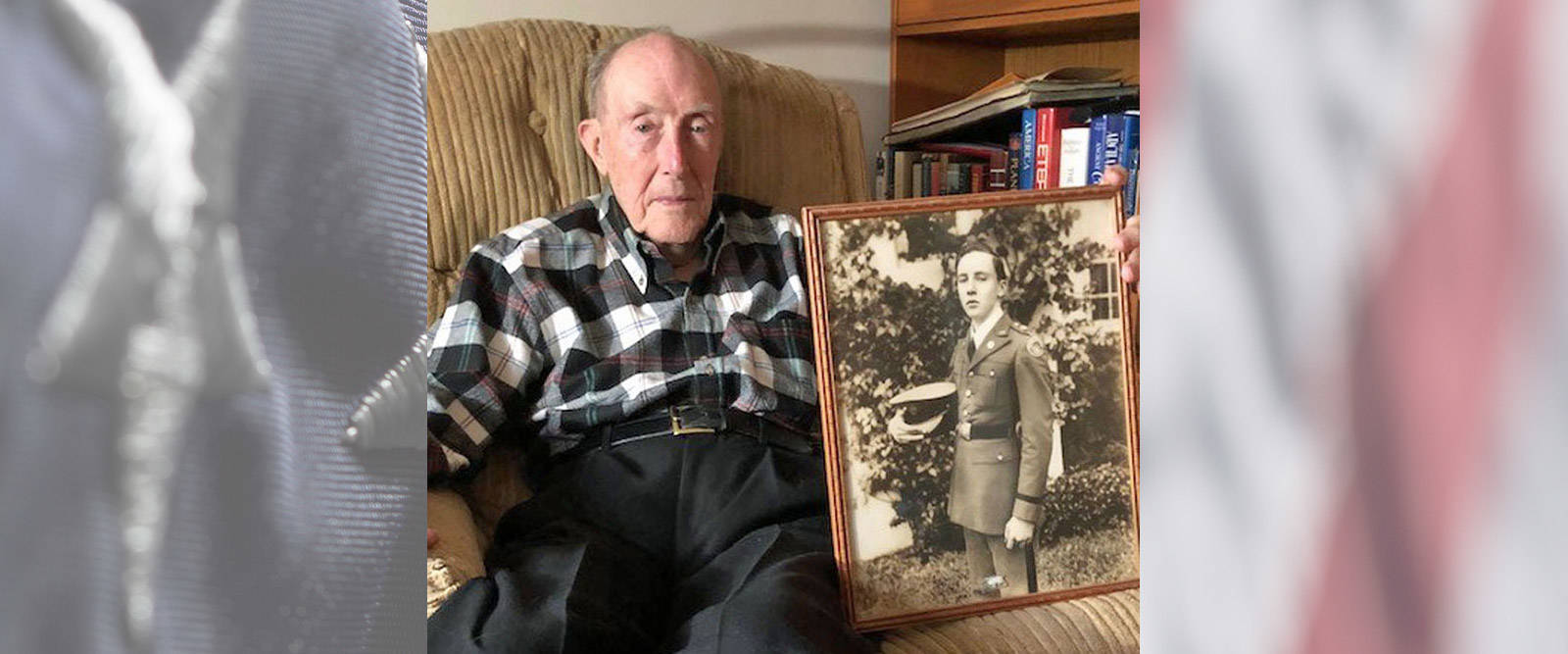U.S. Army World War II Lisle, IL Flight date: 04/11/18
By Charlie Souhrada, Honor Flight Chicago Veteran Interview Volunteer
William (Bill) Vail Howland was born January 4, 1925, in Sussex, New Brunswick, Canada. At six months old, his parents, Frederick Howland and Minnie Eloise Vail, moved to Miami, Florida, in search of opportunity. Eight years later, Bill’s brother, Fred Jr., was born and the family was complete. Growing up, Bill attended grade and high schools in the Miami area. Then, as World War II began to brew, his father enrolled him in Riverside Military Academy in Gainesville, Georgia, for his junior and senior years, to help him prepare for an expected call to serve.
After graduating from Riverside Academy, Bill entered the University of Florida in Gainesville. After studying for one semester, he was drafted into the U.S. Army on April 27, 1943. “I wanted to be a pilot in the Army Air Corps and passed the mental and physical tests, but was told there weren’t any openings and that I’d be notified if something became available … the call never came.” Instead, he reported for duty at Camp Blanding in Starke, Florida, then transferred to Camp Wheeler outside of Macon, Georgia, for boot camp. There he became a naturalized citizen.
Thanks to his academy training, Bill understood military basics and was soon named as squad leader. He remembers marching so much that he thought his legs would fall off. He also remembers training to endure poison gas. “We were given gas masks and herded into specially designed buildings where we were told to take off our masks – then subjected to tear gas. It felt like our eyes were practically bleeding.”
On October 28, he shipped out for Casablanca, French Morocco, to join the European Theater as a member of the 36th Infantry Division, 142nd Regiment, F Company – “The Fighting 36th!” During the nine-day voyage aboard the Empress of Scotland, a converted cruise ship, soldiers slept in bunks stacked four high. “When the guy above you settled down, his butt was within six inches of you!”
After landing in Morocco, he headed for Oran, Algeria by train. The trip took several days, even though the train didn’t seem to stop for anything. Instead, the newly-minted soldiers ate field rations, slept on the boxcar’s floor and, when nature called, carefully answered the call out an open door as the world slowly chugged by. In Oran, Bill began the final leg of his journey to the front lines aboard another troopship, the USS Thomas Jefferson, finally arriving in Naples, Italy, on November 17, 1943. There, one glance changed the course of his entire military career.
“I was looking at the people around me and for some reason, a medical officer caught my eye and motioned me to come over. He said, ‘See that guy over there? Give him your rifle then stand over there with this group of guys.’ I said, ‘Captain, what is this all about?’ He said, ‘Well son, you are no longer a rifleman, you are going to be a medic.’” So, with absolutely no training, not even five minutes of anyone showing him how to apply so much as a band aid, Bill accepted his first assignment on the front lines as a member of a four man, litter – bearer squad. In this role, he followed medics to injured soldiers, picked them up if they couldn’t walk and carried them to an aid station. After one month of watching the medics handle various wounds, usually equipped with nothing but bandages, sulfa, morphine and bandage scissors, he moved from litter – bearer to full-on medic, taking the place of one killed in action.

His on-the-job training and life-changing experiences began to multiply. On February 15, he witnessed row after row of Allied bombers destroy the centuries old Monte Cassino Abbey, in Cassino, Italy, which, at the time, was believed to be a German observation post. And, though Bill never got the pilot training he desired, or the medical training he so desperately needed, he, along with the rest of his division, did undergo amphibious landing training in preparation for a beach invasion at Anzio, Italy. Other army divisions had already started the invasion in January 1944, and were fighting in the mountains around the area. Bill’s division, however, was given the assignment to follow, break through the German lines and move north as fast as possible to help capture Rome. It was here that he witnessed fierce fighting and cheated death when artillery fire shattered a shade tree he had been using for shelter only minutes earlier. Tragically, the blast killed one of his good friends instantly.
As Bill and the Fighting 36th continued their northern push through the Gustav Line, he recalls the Germans always seemed to have control of the higher hills. This occupancy allowed them to see every move and increased the accuracy of their artillery fire. Despite experiencing miserable, dangerous conditions for much of his time in Italy, he got to live like a king during brief visits to the division’s rest camp in Caserta, Italy, in the former palace of the King of Italy. He had a room to himself and heard Frank Sinatra’s music for the first time over the camp’s public address system. After several months of harsh conditions and brutal fighting, the Allies took possession of Rome on June 4. The victory gave Bill and a buddy the chance to explore the Vatican and St. Peter’s Square by themselves. “We got to the Vatican and there wasn’t a soul there, not a single person. We walked around and looked at everything!” Three days later, rear echelon troops came and took over, which allowed the division to continue moving north in pursuit of the German army.
On August 3, Bill’s division landed on Green Beach along the southern coast of France, where they “had a few brief arguments with the Germans,” and continued moving north as fast as possible. The plan was to meet up with Allied troops coming east from Normandy then go across the Rhine into Germany. Some days, the troops got into a truck and traveled 50 miles without a shot being fired. One day, as the troops approached the Vosges Mountains in France, they were surrounded by Germans who pinned them in place for weeks. The group finally broke free with help from the 100th Battalion and the 442nd Regiment, both of which contained Japanese-American soldiers. “They were the most highly decorated units of any in the US forces,” he wrote in his memoirs. “Boy, let me tell you, they deserved it. When I think about how their parents were being treated and what the soldiers accomplished … it was nothing short of amazing.”
Months later, Bill’s platoon was ordered to attack Oberhoffen-sur-Moder, a small village in north-eastern France. They got into a “scrap” and he found himself running from building-to-building, trying to avoid German bullets while tending to soldiers needing help. In recognition of his efforts that day, he was awarded the Silver Star.
Around March 19, 1945, Bill’s division was paired with another in preparation for a morning attack through the German defensive Siegfried Line, about 75 miles north of Strasbourg, in Wissembourg, France. His squad was divided into groups of six or seven soldiers, each assigned to take over a specific pill box or bunker. Just when Bill’s group captured their bunker, the Germans started a vigorous counter attack and captured Bill and his fellow GIs. Ironically, the Germans needed a medic, so, in observation of the Geneva Convention rules in time of conflict, he began providing medical care to the enemy. “If I didn’t, they would have probably shot me.” Bill vividly remembers one, young, German soldier who tried to intimidate him by staring at him while cleaning his fingernails with a large dagger that looked to be issued by the Hitler Youth organization.
For the next few months, as the Americans were chasing the Germans, Bill and his fellow POWs were constantly on the march. “One day, we got strafed by some P47 Thunderbolts, which killed some guys in our POW group.” He estimates there were approximately 300 POWs in the group by the end the march. “I lost 20 pounds on that march because the German army never once fed us, not even one mouthful of food.” About two weeks before the war ended, Bill escaped by hiding in a hayloft with two other POWs. “We knew the Germans were running scared and thought maybe our captors would knock us off to lighten their load.” They waited until dark, snuck into a barn and dug down into the hay against an outside wall. In the morning, they heard camp breaking and knew they were missed. A couple of German soldiers came up in the hayloft with bayonets fixed on their rifles and began prodding around in the hay. An hour later, everyone moved off and Bill and his accomplices fled under cover of darkness that night.
The barn was located near a bridge over the Danube, which was guarded by German troops. As they continued their escape, the trio came to a woodsman’s tin hut, where they found logs and bailing wire to fashion into a crude river raft. “We got down to the water with the raft, started kicking and paddling, but the current was so swift that it became obvious that we were going to be dragged right down under the bridge the Germans were guarding. We called it off and went back to the forest.” Later that night, there was a lot of firing, with tracer bullets going back and forth across the river. They knew that meant the GIs were coming because in any river crossing, the Americans would fire artillery across to the other side to disrupt the defenders. The next morning, Bill’s group heard a track vehicle, like a tank, coming down the road. It was an American half-track, with a soldier on top manning a 50-caliber machine gun. Bill and his partners dropped into a ditch by the side of the road, waited until the half-track got right up next to them, then jumped up and identified themselves. A couple of weeks later, Bill found himself at Camp Lucky Strike, a facility used to take care of American POWs until they could be sent home. He left Europe aboard the USS John Ericsson on May 19 and arrived in New York on May 29.
Unfortunately, thanks to the military’s point system, Bill’s service wasn’t over. Those who had 85 points could be released, yet, after all that he had seen and done during the past two years, he was still one measly point short. So, when he got back home, he enjoyed a 60-day furlough, which was typical for all ex-POWs. Afterwards, he was stationed in St. Petersburg, Florida at the Bay Pines Veterans Hospital for about three months before surpassing the required point total and earning his honorable discharge.
After his military service, Bill completed college and went to work with his father where they built one of the largest construction companies in the country. In 1980, at 55-years-old, he retired, and after traveling a bit, eventually settled in Lisle with his wife, Sally, who died in 2016. He now volunteers with various veterans’ groups and spends time with his family, including his son Bruce, and daughters, Suzanne, Laurie and Kim; five grandchildren and two great-grandchildren.
We commend you Bill for your service and bravery. We hope you enjoy your well-earned, much-deserved Honor Flight!
(Special thanks to Jim Hoch for his significant contributions to this story.)



